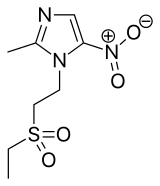Tinidazole
Tinidazole is a drug used against protozoan infections. It is widely known throughout Europe and the developing world as a treatment for a variety of amoebic and parasitic infections. It was developed in 1972 and is a prominent member of the nitroimidazole antibiotic class.[1]
 | |
| Clinical data | |
|---|---|
| Trade names | Fasigyn, Simplotan, Tindamax |
| AHFS/Drugs.com | Monograph |
| MedlinePlus | a604036 |
| Pregnancy category | |
| Routes of administration | Oral |
| ATC code | |
| Legal status | |
| Legal status | |
| Pharmacokinetic data | |
| Protein binding | 12% |
| Metabolism | Hepatic (CYP3A4) |
| Elimination half-life | 12–14 hours |
| Excretion | Urine (20–25%), faeces (12%) |
| Identifiers | |
| |
| CAS Number | |
| PubChem CID | |
| DrugBank | |
| ChemSpider | |
| UNII | |
| KEGG | |
| ChEMBL | |
| NIAID ChemDB | |
| CompTox Dashboard (EPA) | |
| ECHA InfoCard | 100.039.089 |
| Chemical and physical data | |
| Formula | C8H13N3O4S |
| Molar mass | 247.27 g·mol−1 |
| 3D model (JSmol) | |
| |
| |
| (verify) | |
Tinidazole is marketed by Mission Pharmacal under the brand name Tindamax, by Pfizer under the names Fasigyn and Simplotan, and in some Asian countries as Sporinex.
Uses
A large body of clinical data exists to support use of tinidazole for infections from amoebae, giardia, and trichomonas, just like metronidazole. Tinidazole may be a therapeutic alternative in the setting of metronidazole intolerance. Tinidazole may also be used to treat a variety of other bacterial infections (e.g., as part of combination therapy for Helicobacter pylori eradication protocols).[2]
Side effects
Drinking alcohol while taking tinidazole causes an unpleasant disulfiram-like reaction, which includes nausea, vomiting, headache, increased blood pressure, flushing, and shortness of breath.
Half-life
Elimination half-life is 13.2 ± 1.4 hours. Plasma half-life is 12 to 14 hours.
References
- Ebel K, Koehler H, Gamer AO, Jäckh R (2002). "Imidazole and Derivatives.". In Ullmann's Encyclopedia of Industrial Chemistry. Wiley-VCH. doi:10.1002/14356007.a13_661. ISBN 3527306730.
- Edwards DI (January 1993). "Nitroimidazole drugs--action and resistance mechanisms. I. Mechanisms of action". The Journal of Antimicrobial Chemotherapy. 31 (1): 9–20. doi:10.1093/jac/31.1.9. PMID 8444678.